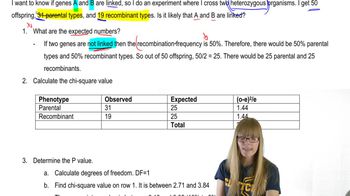Table of contents
- 1. Introduction to Genetics51m
- 2. Mendel's Laws of Inheritance3h 37m
- 3. Extensions to Mendelian Inheritance2h 41m
- 4. Genetic Mapping and Linkage2h 28m
- 5. Genetics of Bacteria and Viruses1h 21m
- 6. Chromosomal Variation1h 48m
- 7. DNA and Chromosome Structure56m
- 8. DNA Replication1h 10m
- 9. Mitosis and Meiosis1h 34m
- 10. Transcription1h 0m
- 11. Translation58m
- 12. Gene Regulation in Prokaryotes1h 19m
- 13. Gene Regulation in Eukaryotes44m
- 14. Genetic Control of Development44m
- 15. Genomes and Genomics1h 50m
- 16. Transposable Elements47m
- 17. Mutation, Repair, and Recombination1h 6m
- 18. Molecular Genetic Tools19m
- 19. Cancer Genetics29m
- 20. Quantitative Genetics1h 26m
- 21. Population Genetics50m
- 22. Evolutionary Genetics29m
2. Mendel's Laws of Inheritance
Sex-Linked Genes
Problem 12b
Textbook Question
On the Drosophila X chromosome, the dominant allele y⁺ produces gray body color and the recessive allele y produces yellow body. This gene is linked to one controlling full eye shape by a dominant allele lz⁺ and lozenge eye shape with a recessive allele lz. These genes recombine with a frequency of approximately 28%. The Lz gene is linked to gene F controlling bristle form, where the dominant phenotype is long bristles and the recessive one is forked bristles. The Lz and F genes recombine with a frequency of approximately 32%.
Using any genotypes you choose, design two separate crosses, one to test recombination between genes Y and Lz and the second between genes Lz and F. Assume 1000 progeny are produced by each cross, and give the number of progeny in each outcome category. (In setting up your crosses, remember that Drosophila males do not undergo recombination.)
 Verified step by step guidance
Verified step by step guidance1
<span>Step 1: Identify the genotypes for the first cross to test recombination between genes Y and Lz. Choose a female with genotype y⁺lz/y⁺lz (homozygous dominant for both traits) and a male with genotype ylz/ylz (homozygous recessive for both traits).</span>
<span>Step 2: Set up the first cross: y⁺lz/y⁺lz (female) x ylz/ylz (male). Since males do not undergo recombination, focus on the female's gametes. Calculate the expected recombinant and non-recombinant gametes based on the recombination frequency of 28%.</span>
<span>Step 3: Calculate the expected number of progeny for each phenotype in the first cross. With 1000 progeny, 28% will be recombinant (gray lozenge and yellow full eye), and 72% will be non-recombinant (gray full eye and yellow lozenge).</span>
<span>Step 4: Identify the genotypes for the second cross to test recombination between genes Lz and F. Choose a female with genotype lz⁺F/lz⁺F (homozygous dominant for both traits) and a male with genotype lzf/lzf (homozygous recessive for both traits).</span>
<span>Step 5: Set up the second cross: lz⁺F/lz⁺F (female) x lzf/lzf (male). Calculate the expected recombinant and non-recombinant gametes based on the recombination frequency of 32%. Determine the expected number of progeny for each phenotype, with 32% recombinant (lozenge long bristles and full eye forked bristles) and 68% non-recombinant (full eye long bristles and lozenge forked bristles).</span>
Recommended similar problem, with video answer:
 Verified Solution
Verified SolutionThis video solution was recommended by our tutors as helpful for the problem above
Video duration:
5mPlay a video:
Was this helpful?
Key Concepts
Here are the essential concepts you must grasp in order to answer the question correctly.
Genetic Linkage
Genetic linkage refers to the tendency of genes located close to each other on the same chromosome to be inherited together during meiosis. This phenomenon affects the inheritance patterns of traits, as linked genes do not assort independently. The degree of linkage can be quantified by recombination frequency, which indicates how often crossing over occurs between the genes during gamete formation.
Recommended video:
Guided course

Chi Square and Linkage
Recombination Frequency
Recombination frequency is a measure of the likelihood that two genes will be separated during meiosis due to crossing over. It is expressed as a percentage, with higher values indicating greater distances between genes on a chromosome. In the context of the question, the recombination frequencies of 28% and 32% for the respective gene pairs suggest that these genes are linked but not tightly, allowing for some degree of genetic variation in the progeny.
Recommended video:
Guided course

Recombination after Single Strand Breaks
Drosophila Genetics
Drosophila melanogaster, commonly known as the fruit fly, is a model organism widely used in genetic studies due to its simple genetic structure and short life cycle. In Drosophila, males are hemizygous for X-linked genes and do not undergo recombination during meiosis, which simplifies the analysis of X-linked traits. Understanding the inheritance patterns in Drosophila is crucial for designing crosses and predicting progeny outcomes based on the principles of Mendelian genetics.
Recommended video:
Guided course

Drosophila P Element

 7:56m
7:56mWatch next
Master Sex-Linked Genes with a bite sized video explanation from Kylia Goodner
Start learningRelated Videos
Related Practice



